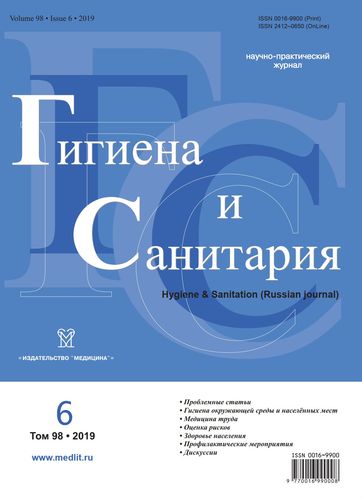Ways for minimizing the negative effect tobacco aerosol components during passive smoking
- Authors: Markova O.L.1, Kiryanova M.N.1, Ivanova E.V.1, Zaritskaya E.V.1
-
Affiliations:
- North-West Public Health Research Center
- Issue: Vol 98, No 6 (2019)
- Pages: 682-687
- Section: PREVENTIVE MEASURES
- Published: 15.06.2019
- URL: https://rjsocmed.com/0016-9900/article/view/639609
- DOI: https://doi.org/10.47470/0016-9900-2019-98-6-682-687
- ID: 639609
Cite item
Full Text
Abstract
Introduction. There are reported air quality assessment findings in enclosed spaces in experimental conditions using two kinds of nicotine-containing products - cigarettes and electronic nicotine delivery system (ENDS), seem to be the most common types of smoking.
Мaterial and Methods. In the process of the experiment concentrations of tobacco aerosol components, i.e.: 12 chemicals and two aerosols were measured. Studies were carried out in isolated rooms under monitored microclimate parameters and uniform air mixing. Groups of volunteers using cigarettes or electronic nicotine delivery systems and the control non-smoker group participated in the study; everybody gave their informed consent for participation in the experiment. Control of background indices for comparison of air quality in rooms where tobacco products were being smoked was carried out.
Results. Our studies allowing to identify chemicals evolving into the air of enclosed rooms where “PARLAMENT Aqua Blue” cigarettes were smoked or electronic tobacco delivery systems “CRICKET Classic 3.0” were used, to estimate total amount of chemicals in air. Prevailing chemicals affecting human health, which can be recommended for the use in calculations and air study of enclosed rooms exposed to tobacco aerosol, were identified. Estimated values of adverse chemical concentrations, air flow and air expenditure rate, resulting from experimental data allow designing ventilation system with regard to hygienic requirements based on maximum allowable concentration values for atmospheric air.
Conclusions. Suggested recommendations on calculation of ventilation parameters to produce comfortable human environment in passive smoking conditions will improve air quality in public buildings.
About the authors
Olga L. Markova
North-West Public Health Research Center
Author for correspondence.
Email: olleonmar@mail.ru
ORCID iD: 0000-0002-4727-7950
MD, Ph.D., senior researcher, Department of Population Health Risks Analysis, North-West Public Health Research Center, Saint-Petersburg, 191036, Russian Federation.
e-mail: olleonmar@mail.ru
Russian FederationM. N. Kiryanova
North-West Public Health Research Center
Email: noemail@neicon.ru
ORCID iD: 0000-0001-9037-0301
Russian Federation
E. V. Ivanova
North-West Public Health Research Center
Email: noemail@neicon.ru
ORCID iD: 0000-0001-9461-9979
Russian Federation
E. V. Zaritskaya
North-West Public Health Research Center
Email: noemail@neicon.ru
ORCID iD: 0000-0003-2481-1724
Russian Federation
References
- Tobacco. Newsletter May 2015; WHO 339. Electronic resource. URL: http://www.who.int/mediacentre/factsheets339/ru/
- California Environmental Protection Agency: Air Resources (2005). Proposed Identification of Environmental Tobacco Smoke as a Toxic Air Contaminant. UC San Francisco, Surveys and Program Evaluations from Outside UCSF. https://escholarship.org/uc/item/8hk6960q
- Counts M.E.; Morton M.J.; Laffoon S.W.; Cox R.H.; Lipowicz P.J. Smoke composition and predicting relationships for international commercial cigarettes smoked with three machine-smoking conditions. Regul. Toxicol. Pharmacol. 2005; 41: 185-227.
- Caruso R.V.; O’Connor R.J.; Stephens W.E.; Cummings K.M.; Fong G.T. Toxic metal concentrations in cigarettes obtained from U.S. smokers in 2009: Results from the International Tobacco Control (ITC) United States survey cohort. Int. J. Environ. Res. Public Health. 2014; 11: 202-17.
- Bikkinina G.M. Problems of tobacco smoking as a modifiable risk factor for law enforcement officers. Fundamental’nye issledovania. 2011; 7: 27-30. (In Russian).
- Smirnova M.A. Efficacy of giving up smoking with individual telephone counseling in patients with chronic obstructive pulmonary disease and pulmonary tuberculosis. Klinicheskaya i eksperimental’naya meditzina. 2017; 19(3): 40-4. (In Russian).
- Maya I. Mitova, Pedro B. Campelos, Catherine G. Goujon-Ginglinger, Serge Maeder, Nicolas Mottier, Emmanuel G.R. Rouget, Manuel Tharin, Anthony R. Tricker. Comparison of the impact of the Tobacco Heating System 2.2 and a cigarette on indoor air quality. Regulatory Toxicology and Pharmacology. 2016; 80: 91-101.
- Oberg M., Jaakkola M.S., Woodward A., Peruga A., Pruss-Ustun A Woldwide burden of disease from exposure to second-hand smoke: retrospective analysis of data from 192 countries. The Lancet.2011; 377.9760: 139-146.
- Global Adult Tobacco Survey (GATS): Russian Federation 2009. Counrtry report: http://www.who.int/tobacco/surveillance/en_tfi_gats_russian_countryreport.pdf
- Titova O.N., Kulikov V.D., Sukhovskaya O.A. Passive smoking and respiratory diseases. Meditzinskii al’yans. 2016; (3): 73-7. (In Russian).
- Eisner M.D., Balmer J., Katz P.P.,Trupin L., Yelin E.H., Blane P.D. Lifetime environmental tobacco smoke exposure and the risk of chronic obstructive pulmonary disease. Environ Health. 2005; 4.
- California Environmental Protection Agency, 1997; US. Environmental Protection Agency, 1992; International Agency for Research on Cancer, 2004; US Department of Health and Human Services, 2006; United States Pharmacopeia, 2014.
- Zubairova L.D., Zubairov D.M. Smoking as a risk factor for cardiovascular diseases. Kazanskii meditsinskii zhurnal.2006; 87; 5: 369-73. (In Russian).
- Jordan R.E., Cheng K.K., Miller M.R., Adab P. Passive smoking and chronic obstructive pulmonaru disease: cross-sectional analysis of data the Health Survey for England. BMJ Open. 2011; 1- http://bmjopen.bmj.com/content/1/2/e000153.full/
- Krasnova Yu.N. Effect of tobacco smoke on respiratory system. Sibirskii meditzinskii zhurnal. 2015; (6): 11-5. (In Russian).
- Pokhaznikova M.A., Kuznetzova O.Yu., Lebedev A.K. Prevalence of passive smoking and other risk factors for chronic obstructive pulmonary disease in St.-Petersburg. Rossiiskii Semeinyi vrach. 2015; 4: 21-8. (In Russian).
- Kir’yanova M.N., Markova O.L., Ivanova E.V. Current issues of air quality in office premises. Sbornik materialov “Vserossiiskoi NPK с mezhdunarodnym uchastiem “Profilakticheskaya meditsina”. 2017; 9-14. (In Russian).
- Markova O.L., Ivanova E.V. Current decisions to improve air quality at the workplaces of electric welders. Meditsina truda i promyshlennaya ekologia. 2015; 2: 5-8. (In Russian).
- Markova O.L., Ivanova E.V., Zaritskaya E.V. Search for solutions to minimize the risk to health in passive smoking. Sbornik. Trudy XIII Vserossiiskoi nauchno-prakticheskoi konferentsii s mezhdunarodnym uchastiem. 2018; 13; 2: 882-91. (In Russian).
- Brodach M.M., Brosema B., Naumov A.L., Pershin A.N. Smoking areas. Design of ventilation systems. Moscow: AVOK- PRESS, 2013; 144. (In Russian).
- Dudarev A.A., Krupkin G.Ya., Turubarov V.I., Burtsev S.I., Kaptsev V.V., Nikitina V.N., Dubeikovskaya L.S., Markova O.L. Air environment of modern office facilities. An integrated approach to hygienic assessment and quality management of air. Meditsina truda i promyshlennaya ekologia. 2004; 1: 37-40. (In Russian).
- Kvashnin I.M. Industrial atmospheric emissions. Engineering calculations and inventory. M.AVOK-RESS.2005; 13. (In Russian).
Supplementary files









